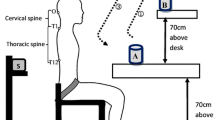Abstract
The study investigated the possible association between nocturnal trapezius muscle activity and shoulder and neck pain. Sixty female subjects participated in the study, 33 were classified as pain-afflicted on the basis of shoulder and neck pain reports for the previous 6 months. Electromyographic (EMG) activity was monitored bilaterally from the trapezius in all recordings. EMG recording of the deltoid, biceps, and hand flexors was included for 26 subjects (17 with pain) to provide a comparative basis for evaluation of the trapezius recordings. There was considerable variation in the amount of muscle activity between subjects; however, some subjects presented a continuous, low-level activity pattern throughout the presumed sleep period. Subjects classified as pain-afflicted had significantly higher activity level and longer duration of trapezius EMG activity than the pain-free subjects. The deltoid had significantly more activity than the trapezius, while the biceps and the hand flexors presented similar activity level and duration as the trapezius. Nocturnal trapezius activity was not associated with pain exacerbation the same night. We suggest nocturnal trapezius muscle activity is a pointer to physiological mechanisms that contribute to some forms of shoulder and neck pain, such as trapezius myalgia, but nocturnal muscle activity may not be casually implicated in the pain-induction process.




Similar content being viewed by others
References
Arduini A, Berlucchi G, Strata P (1963) Pyramidal activity during sleep and wakefulness. Arch Ital Biol 101:530–544
Ashburn MA, Staats PS (1999) Management of chronic pain. Lancet 353:1865–1869
Buskila D (2000) Fibromyalgia, chronic fatigue syndrome, and myofascial pain syndrome. Curr Opin Rheumatol 12:113–123
Fischer AA, Chang CH (1985) Electromyographic evidence of paraspinal muscle spasm during sleep in patients with low back pain. Clin J Pain 1:147–154
Glenn LL, Dement WC (1981) Membrane potential, synaptic activity, and excitability of hindlimb motoneurons during wakefulness and sleep. J Neurophysiol 46:839–854
Hägg GM (1991) Static work loads and occupational myalgia—a new explanation model. In: Anderson PA, Hobart DJ, Danoff JV (eds) Electromyographical kinesiology. Elsevier, Amsterdam, pp 141–143
Hatch JP, Prihoda TJ, Moore PJ, Cry-Provost M, Borcherding S, Boutros NN, Seleshi E (1991) A naturalistic study of the relationship among electromyographic activity, psycological stress, and pain in ambulatory tension-type headache patients and headache-free controls. Psychosom Med 53:576–584
Holte KA, Westgaard RH (2002a) Daytime trapezius muscle activity and shoulder-neck pain of service workers with work stress and low biomechanical exposure. Am J Ind Med 41:393–405
Holte KA, Westgaard RH (2002b) Further studies of shoulder and neck pain and exposures in customer service work with low biomechanical demands. Ergonomics 45:887–909
Holte KA, Vasseljen O, Westgaard RH (2003) Exploring perceived tension as a response to psychosocial work stress. Scand J Work Environ Health 29:124–133
Hyyppä MT, Kronholm E (1995) Nocturnal motor activity in fibromyalgia patients with poor sleep quality. J Psychosom Res 39:85–91
Jensen C, Vasseljen O, Westgaard RH (1993) The influence of electrode position on bipolar surface electromyogram recordings of the upper trapezius muscle. Eur J Appl Physiol 67:266–273
Lavigne GJ, Velly-Miguel AM, Montplaisir J (1991) Muscle pain, dyskinesia, and sleep. Can J Physiol Pharmacol 69:678–682
Lobbezoo F, Thon MT, Rémillard G, Montplaisir JY, Lavigne GJ (1996) Relationship between sleep, neck muscle activity, and pain in cervical dystonia. Can J Neurol Sci 23:285–290
Marchiafava PL, Pompeiano O (1964) Pyramidal influences on spinal cord during desynchronized sleep. Arch Ital Biol 102:500–529
Melin B, Lundberg U (1997) A biopsychosocial approach to work-stress and musculoskeletal disorders. Int J Psychophysiol 11:238–247
Moldofsky H (2001) Sleep and pain. Sleep Med Rev 5:387–398
Simons DG, Mense S (1998) Understanding and measurement of muscle tone as related to clinical muscle pain. Pain 75:1–17
Simons DG, Travell JG, Simons LS (1999) Myofascial pain and dysfunction. The trigger point manual, vol 1, Upper half of body. Williams and Wilkins, Baltimore
Sjøgaard G, Lundberg U, Kadefors R (2000) The role of muscle activity and mental load in the development of pain and degenerative processes at the muscle cell level during computer work. Eur J Appl Physiol 83:99–105
Vasseljen O, Westgaard RH (1996) Can stress-related shoulder and neck pain develop independently of muscle activity? Pain 64:221–230
Vasseljen O, Westgaard RH, Larsen S (1995) A case-control study of psychological and psychosocial risk factors for shoulder and neck pain at the workplace. Int Arch Occup Environ Health 66:375–382
Vasseljen O, Holte KA, Westgaard RH (2001) Shoulder and neck complaints in customer relations: individual risk factors and perceived exposures at work. Ergonomics 44:355–372
Westgaard RH (1999) Effects of physical and mental stressors on muscle pain. Scand J Work Environ Health 25 [Suppl 4]:19–24
Westgaard RH, Jansen T (1992) Individual and work related factors associated with symptoms of musculoskeletal complaints. I. A quantitative registration system. Br J Ind Med 49:147–153
Westgaard RH, Vasseljen O, Holte KA (2001) Trapezius muscle activity as a risk indicator for shoulder and neck pain in female service workers with low biomechanical exposure. Ergonomics 44:339–353
Westgaard RH, Bonato P, Holte KA (2002) Low-frequency oscillations (<0.3 Hz) in the electromyographic (EMG) activity of the human trapezius muscle during sleep. J Neurophysiol 88:1177–1184
Acknowledgement
This work was supported by a grant from the Norwegian Research Council.
Author information
Authors and Affiliations
Corresponding author
Rights and permissions
About this article
Cite this article
Mork, P.J., Westgaard, R.H. The association between nocturnal trapezius muscle activity and shoulder and neck pain. Eur J Appl Physiol 92, 18–25 (2004). https://doi.org/10.1007/s00421-003-1039-4
Accepted:
Published:
Issue Date:
DOI: https://doi.org/10.1007/s00421-003-1039-4




